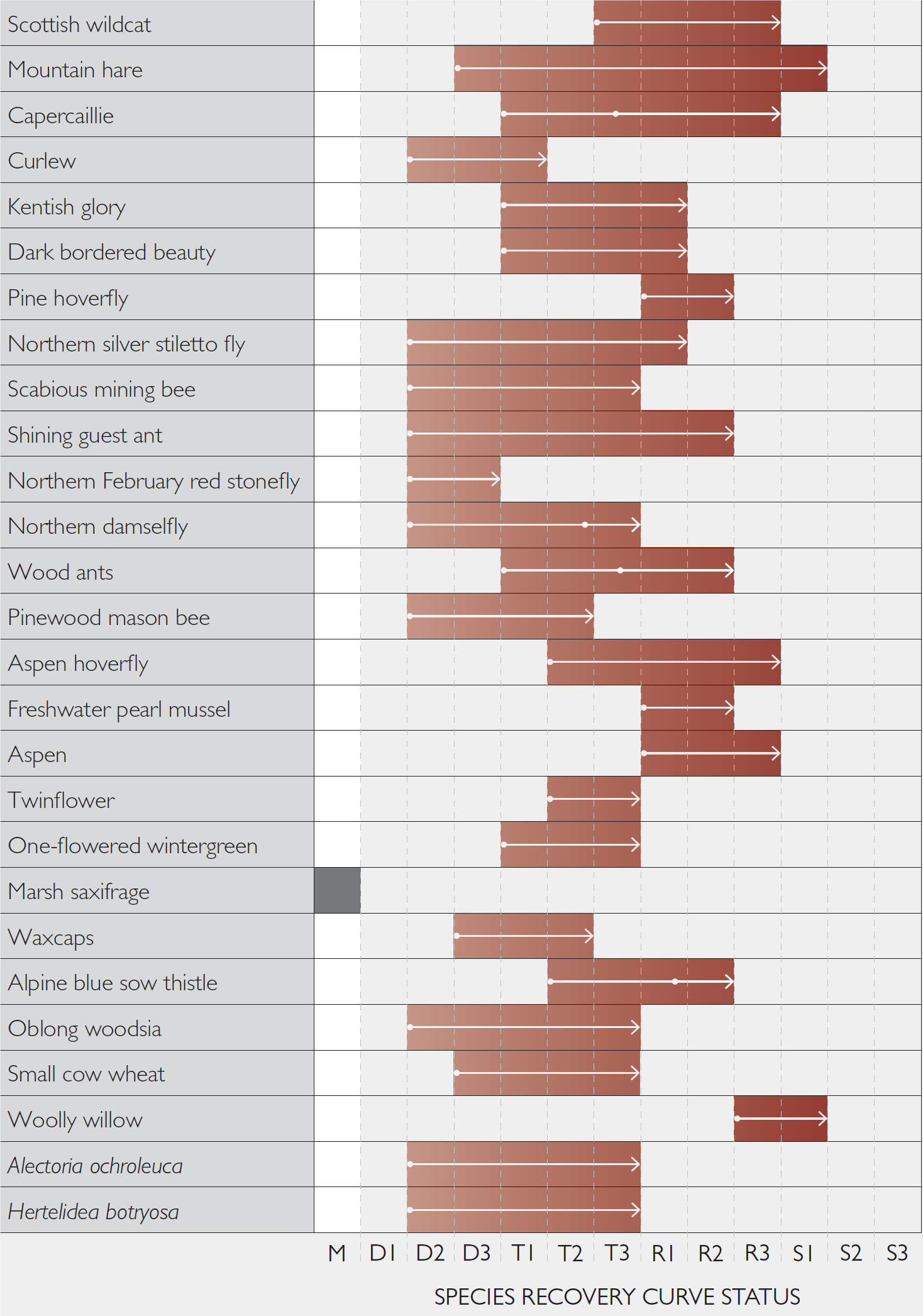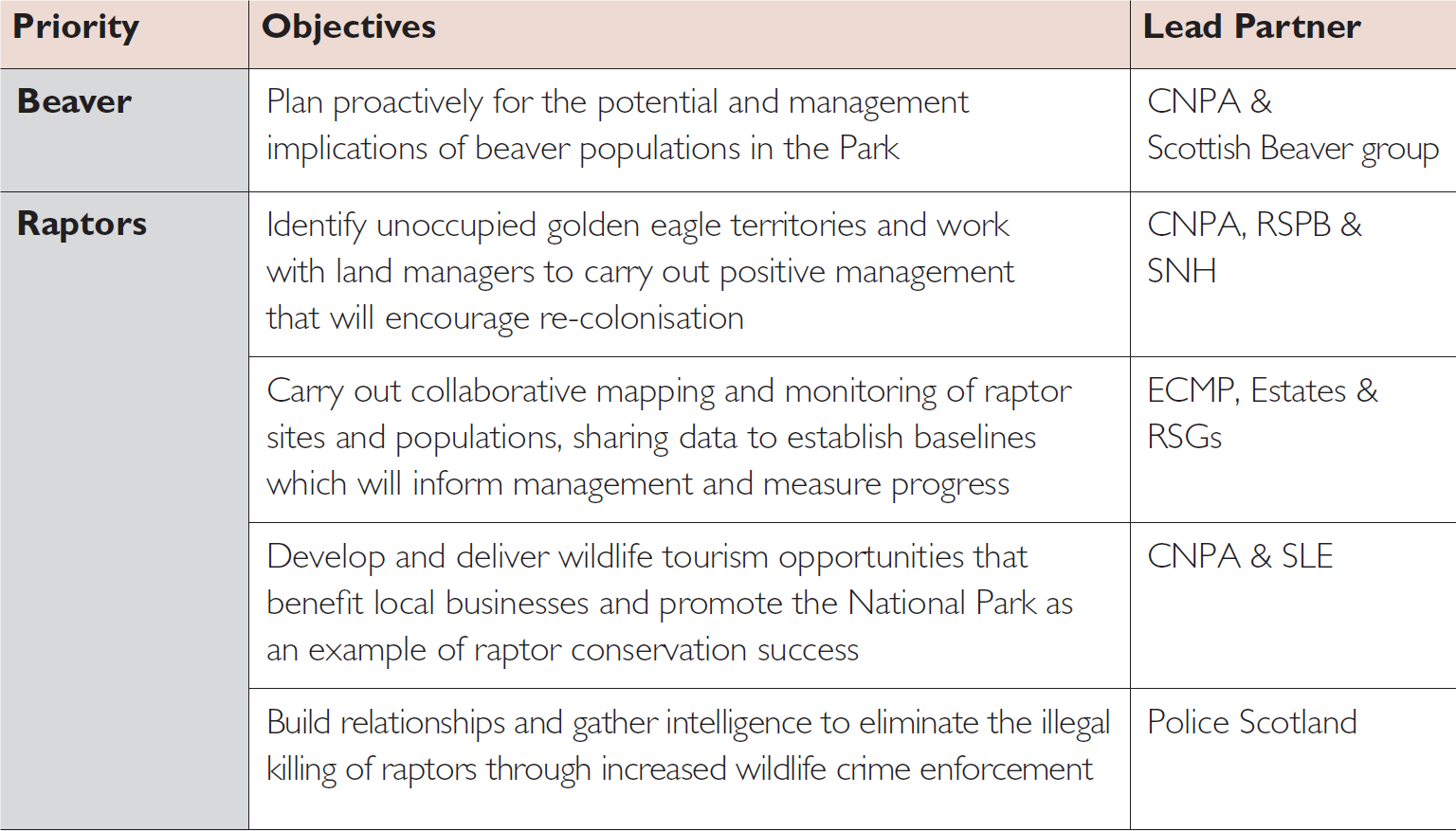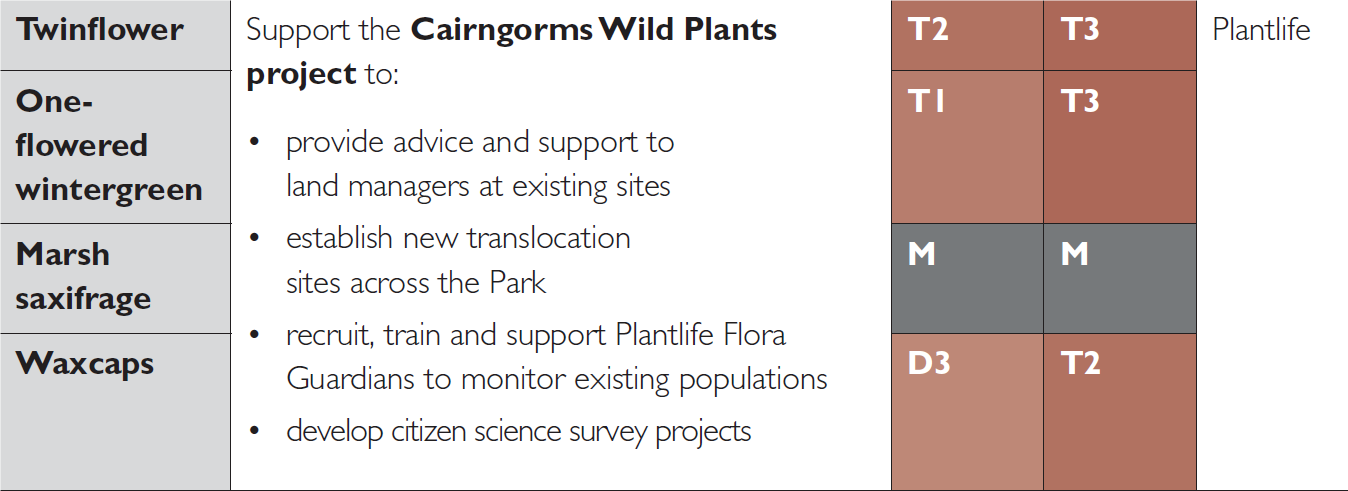The consultation on the draft Cairngorms Nature Action Plan closes tomorrow on Friday 14th September. A month ago (see here) I considered the context for the plan and the proposed priorities for landscape scale conservation: farmland, freshwater restoration, woodland expansion and peatland . This post will look at the other two professed aims of the plan, targetted action for species and involving people in nature conservation. I apologise to readers that this post is so close to the end of the consultation period but its not too late to respond and you can do so here.
Focussed action for species
The second aim of the plan is “to deliver focussed action to improve the conservation status of threatened or declining species” and the main objective is to get “species back on a sustainable footing, where they are no longer reliant on targeted action, but have been recovered within a robust and resilient network of habitats”.
The consultation asks whether the Plan had identified the right species for targetted research and action, which are as follows:

There are some positive things about this approach. First and foremost, this public commitment to reverse the decline of certain species when across the world we are faced with mass extinctions and very little action, is important. Not many public agencies are doing this in Scotland and the Loch Lomond and Trossachs National Park, for example, has basically abandoned nature conservation entirely, devoting almost no resources to the issue except to market species such as the Red Squirrel as a tourist opportunity. The CNPA has retained its conservation staff and continues to commit resources to conservation and that is very important. Second, and linked to this, its positive that the CNPA is focussing not just on “iconic” species but also on species many people are unlikely ever to have heard of – like the lichen Alectoria ochroleuca.
The CNPA has also made some significant and positive shifts in the year since the publication of its overriding Partnership Plan:
- Mountain Hare is now firmly up there as a species under threat whereas previously the CNPA had followed Scottish Natural Heritage’s line that more research was needed to ascertain whether the species was threatened or not. This is welcome.
- Curlew has been added to the list reflecting the recent collapse in wader numbers (and this is linked to the addition of farmland as a priority habitat since the production of the Partnership Plan)
- And, tacked on at the end of the list, there is another table (the status of which is unclear having “objectives” rather than actions and omitting the information about where these species are on the recovery curve) which includes:

Beavers did not even warrant a mention in the Cairngorms National Park Partnership Plan, despite CNPA staff having done work to identify sites for beaver re-introduction, including Insh Marshes and Dinnet. This is therefore a welcome is a step forward even if the CNPA is still not actually backing their introduction. The reality is that with the rapid colonisation of the Tay and other Perthshire rivers by beavers it is unlikely to be long before they start to colonise the National Park and the CNPA needs to pre-empt the inevitable outcry by farming interests. The CNPA has a great opportunity here to show that rather than beavers being a problem, they will make a positive contribution to flood control and prevention, increased biodiversity and people’s enjoyment of the countryside.
The increased emphasis on raptors is also a step forward even if the actions proposed are inadequate.
The big question is whether this approach to species is sufficient?
The Action Plan identifies 27 out of 1200 species found in the National Park which are considered to be nationally or internationally important for targetted action – that is just over 2%. No data is provided about how many of these 1200 species are threatened and therefore whether identifying 27 (or it is 29 with beaver and “raptors”) goes anywhere near addressing need.
To be fair to the CNPA they do acknowledge this:
Action for species not included in the projects’ remit proved challenging to fund, often requiring
specialist skills and experience to survey. Without baseline data and comprehensive monitoring
it was impossible to make an assessment of populations, so, going forward, Cairngorms
Nature is trialling the use of the Species Recovery Curve to establish progress and achievements.
In other words the species identified are those which have obtained funding for action, for example through the Cairngorms Wild Plants project:
 My guess is that behind the scenes the CNPA know this is insufficient but are constrained politically from asking for the resources necessary for effective conservation.
My guess is that behind the scenes the CNPA know this is insufficient but are constrained politically from asking for the resources necessary for effective conservation.
Its questionable too whether some of the priority species identified really need “targetted action” rather than habitat restoration, which the Plan rightly says is the key to most species recovery. For example, while its great the CNPA has recognised the plight of the curlew, does it really need targetted action rather than the general adoption of more nature and wader friendly farming practices? Targetted action should be reserved for situations where habitat restoration, including by natural regeneration over time, is unlikely by itself to enable a species to recover.
Also missing from the draft Plan is a general account of why so many species have declined in the National Park. The explanation lies in management practices and, while the intensification of farming and forestry are important here, it is the management of land for “sporting” purposes which has had by far the biggest impact in the National Park. There are two aspects to this, first the destruction of habitats – primarily through deer overgrazing and muirburn – on which species depend, the second the systematic prioritisation of red deer and red grouse above all other species. In the case of grouse moor management this has involved the persecution and elimination of many other species.
In my view until all wildlife, with exceptions for Red Deer and game birds, is protected in our National Parks the fundamental factor affecting species decline will continue. We need to protect not just mountain hare but stoat and weasel, not just hen harrier but crow and raven. The important concept here is the one of trophic cascades (see here) where top predators have been shown to play a key role in increasing biodiversity (or the range and health of threatened species). The Cairngorms Nature Action Plan contains no discussion about the key role in predators in biodiversity nor how they might be protected in the National Park (the CNPA could introduce byelaws protecting all wildlife within the period of this plan if it had the will).
Nor is there any vision for the future: it will take longer than five years to re-introduce the wolf in Scotland (key for addressing the adverse impacts of Red Deer grazing) but lynx? Lynx could play a very positive role in woodland restoration, one of the primary landscape aims of the National Park, by keeping roe deer, its favourite prey, in check – so why is it not mentioned?
There is no rational reason why the Cairngorms Nature Action Plan could not have at least floated ideas for further species re-introduction (as it has half done for the beaver). That it has not done so provides, I believe, more evidence of the grip that some sporting estates still have over this National Park.
Involving People

The third aim of the Nature Action Plan is “Engaging, inspiring and encouraging local communities
and communities of interest to value and care for nature, be proud of the conservation work in the Cairngorms and want to do something to protect and enhance their natural heritage”
I think it is right that people are crucial to the protection of wildlife and should be involved although I would question the implication here that people need inspiring. The evidence, such as the recent outcries over mountain hare and raven culling, is that people are ahead of our Public Authorities when it comes to nature conservation, they just don’t have the power to effect change. I would include in this some farmers and land managers, who would like to manage the land more sustainably and contribute to landscape scale conservation: the problem is the current subsidy and market system limits the ways they can use the land and at the same time benefit wildlife.
This is not to say that people could not learn more about nature – the vast majority of the population are disconnected from land and wildlife – and that the National Park should not provide opportunities for people to experience and appreciate nature. Staff in the National Park have done some excellent work on this and arguably one of the CNPA’s successes has been the contribution it has made to increasing public awareness and understanding of habitats such as the Caledonian Pine Forest.
The problem in the Plan though is all of this is top down. The claim is that:
“As a partnership the aim is to be inclusive, to consult and seek agreement, to use evidence and to tackle difficult issues by building trust and relationships through discussion and collaboration and ultimately making a difference on the ground.”
AND
“Cairngorms Nature is an informal partnership open to all. It’s an opportunity for people and organisations from all backgrounds to come together with one thing in common: a love of the Cairngorms National Park’s wildlife and the desire to do something to protect it.”
The reality is that power lies with a few organisations, starting with landowners:

AND
“Membership of the strategy group is open to agencies and organisations with a direct involvement in the delivery of biodiversity gain in the Cairngorms National Park with the agreement
of existing members. The current membership, to be reviewed after formal adoption of the Action
Plan 2018-2023, is:
• Cairngorms National Park Authority
• Crown Estate Scotland
• River Dee Trust
• Forestry Commission Scotland
• Marr Area Partnership
• National Farmers Union Scotland
• National Trust for Scotland
• Royal Society for the Protection of Birds
• Scottish Environment Protection Agency
• Scottish Land and Estates
• Scottish Gamekeepers Association
• Scottish Natural Heritage
• Wildland Ltd”
You only need to look at the omissions to see what is really going on:
- no place for Raptor Persecution Scotland or any of the Raptor Study Groups involved in the Cairngorms – despite their critical role in promoting understanding of how raptors are being systematically eliminated from much of the National Park;
- no place for the grass roots Badenoch and Strathspey conservation group, despite (or perhaps is it because of) all the recording they do of rare plants and invertbrates;
- no place for recreational interests, such as the North East Mountain Trust, Mountaineering Scotland or Ramblers Scotland who were at the forefront of attempts to create a National Park in the first place
- no place for the Cairngorms Campaign, despite its expertise
- no place for community woodlands, despite what they have done for nature conservation
The type of organisation which might argue that the good work Wildland Ltd is doing around Glen Feshie and the NTS at Mar Lodge should be extended to other areas of the National Park is conspicuous by its absence.
CNPA need to cut out the spin and consider how to build a truly inclusive partnership. Unfortunately, instead of consulting on how to do this as part of the Nature Action Plan, they have said they will do so once the consultation is over (behind closed doors). That doesn’t inspire much confidence that there will be meaningful improvements in the state of nature in the National Park over the next five years. I am optimistic though that if enough people speak out now the CNPA will continue to make some further shifts towards fulfilling its conservation purpose and would encourage readers to respond to the consultation.
